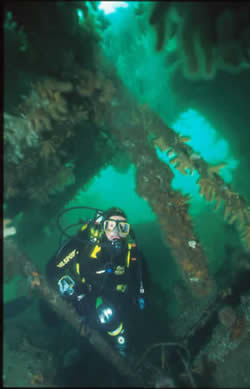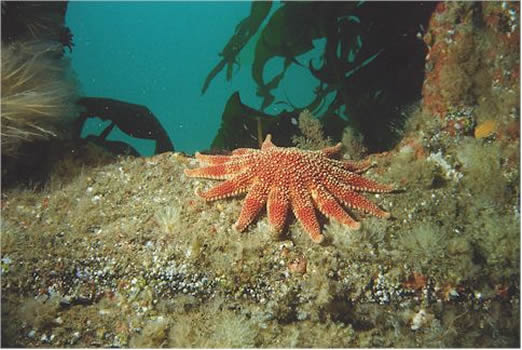The Wrecks of Burra Sound
Scapa Flow was used in both world wars as the main harbour for the British Navy. To safeguard the fleet as they lay at anchor, attempts were made to block all the main entrances into the Flow. Anti-submarine netting was suspended on floating booms and strung across larger channels, sections much like gates. These could be opened to allow British vessels to pass. Tidal races in the smaller sounds meant that laying mines was impossible so instead blockships were sunk to block the channels.
Blockships continued to be used as a means of closing Burra Sound throughout both world wars. Although some have been dispersed, the remains of these make up some of the best diving in Scapa Flow today, with average visibility of 20-30 metres and an abundance of marine life. Today the remains of eight blockships lie in Burra Sound. A tidal race of 5-6 knots runs through Burra Sound, so these wrecks can only be dived at slack water.

Inverlane 8900-ton Dublin registered tanker, she was built in Vegesack, West Germany in 1938. She hit a mine off South Shields in 1939 and was split in two. Her stern section still lies off South Shields. Her bow section and midships were made watertight and towed to Burra Sound and sunk in her present position in1944.
She has now sunk below the water line so is no longer visible from the surface.
Gobernador Bories. Chilean registered 2.332-ton steamer sunk in position in Burra Sound in 1915. She lies in 16-21 metres of water with a list to starboard. A strong tidal stream through Burra Sound means she can only be dived at slack waters. The hull amidships is fairly broken up, and the decking has collapsed in most parts giving easy access to inner parts of this wreck. The bow and starboard side of the hull are fairly intact, and the stern still boasts her large propeller and rudder. This same tide ensures good visibility, and the wreck is teeming with life, and you are usually followed around the wreck by large ballen wrasse waiting to be offered a tasty morsel. This dive is a real must for photographers. (see below)
The above three photos are courtesy of Lawson Wood © Lawson Wood
Doyle. 1.761 ton Belfast registered single screw steamer sunk in position in Burra Sound in 1940. Lying close to the Inverlane, she sits in 15-18 metres of water on an even keel with an obvious list to port. Her stern and starboard side are relatively intact, giving some shelter from any tide. Her propeller is still in place at her stern, sitting proud of the seabed. Inside there are three levels of decking to explore, with her two masts lying to starboard. Like all the other wreckage in Burra Sound, she is covered in marine life, and shallower sections have a lot of kelp growth. A strong tidal stream through Burra Sound means she can only be dived at slack waters.
The above three photos are courtesy of Lawson Wood © Lawson Wood
Tabarka. 2,642-ton steamer built in Rotterdam. Originally sunk in Kirk Sound, she was moved to her present position by the Royal Navy in 1940. Lying upside down in 12-15 metres of water off the Inverlane. One or two holes that have been blasted in her hull allow access to the wreckage, and the boiler room and engine rooms can be accessed through the bulkheads. Many of her internal workings can still be seen. Most of the dive is spent inside the wreck. A strong tidal stream through Burra Sound means she can only be dived at slack waters. This is a favourite dive and has been likened to diving in a cathedral with all the light pouring through its many holes.
The above three photos are courtesy of Lawson Wood © Lawson Wood
Burra Sound Drift. Remains of four other blockships can be found scattered in Burra Sound, all of them steel single-screw steamers: The Budrie (2,252 tons, built Glasgow 1882), Rotherfield (2,831 tons, built West Hartlepool 1889), Ronda (1,941 ton, built Sunderland 1889) and the Urmstone Grange (3,423 ton, built Belfast 1894). These were all sunk in Burra Sound between 1914 and 1915. The Royal Navy blasted them in 1962, and the wreckage that remains is covered in kelp and marine life. This can make for a very exciting drift dive, definitely not for the faint hearted!
